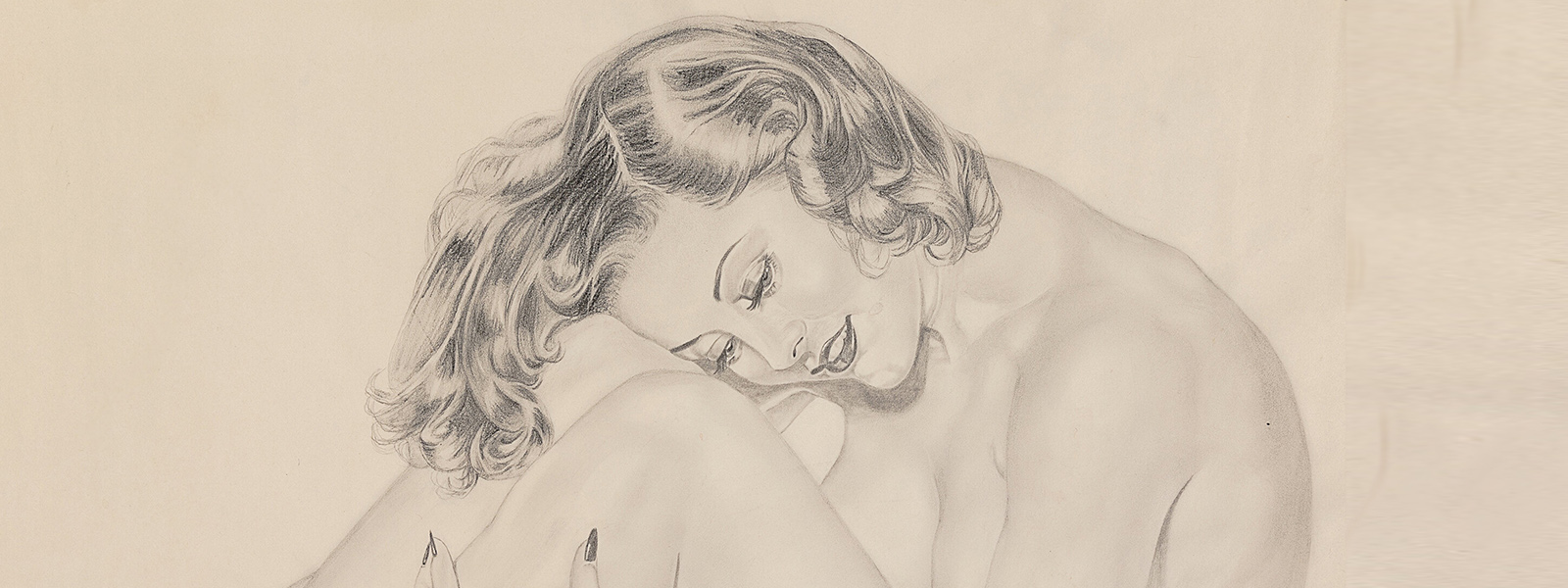AUGUST 17 AUCTION PAYS TRIBUTE TO THE CELEBRATED PERUVIAN AMERICAN ARTIST AND HIS COME-HITHER IMAGES THAT HAVE TEASED AND TANTALIZED FOR DECADES
By Christina Rees
Follow the timeline of humanity and you will find eroticism. From Paleolithic cave paintings to the Venus of Willendorf to Chaucer to the Marquis de Sade to Larry Flynt and beyond, people have demanded access to the things that turn their crank – and found the makers who would deliver. Any attempt to control the impulse is a game of Whac-A-Mole. Much innovation has been driven by an endless appetite for hot content or enlisted to serve it as soon as it appears: the printing press, photography, film cameras, VHS, cell phones.
Now that the digital revolution has brought us free porn on demand through any screen, we look back with some wistfulness at the relative innocence of the erotic output of the 20th century and what could be described as the last decades shaped by imagination as much as restraint – with a dash of glamour and romance to boot: the Ziegfeld Follies, Bettie Page, Oui magazine, stag movies, Henry Miller, Warhol’s Blow Job. The list goes on. To your taste or not, an erotic art form that defined the 20th century up until the 1970s Golden Age of Porn was the pinup. Whether photographed, drawn, painted or airbrushed, the solo female form in some variation of come-hither pose and undress dominated the field, and the name that epitomizes decades of pinup popularity is Alberto Vargas.
ALBERTO VARGAS SHOWCASE AUCTION 15204
August 17, 2023
Online: HA.com/15204
INQUIRIES
Meagen McMillan
214.409.1546
MeagenM@HA.com
The Peruvian American artist-illustrator got his professional start presenting beautiful women as early as 1919, but for a lot of Gen Xers, our first brush with Vargas was one of the last images he created: the iconic 1979 album cover for the Cars’ Candy-O. It’s a great Vargas; it sweeps an entire aesthetic history into one steamy image, and my sense is that all of us got it because the pinup – the slyness and sophistication and fun of Vargas’ pinups in particular – had informed so much pop culture that made up the very air we breathed. The Vargas girl – and Candy-O is very much one – was and is the history of 20th-century America. Vargas, and his women, had a hell of a run.
Vargas was as well known for his earliest work with the Ziegfeld Follies in the 1920s and ’30s as he was for his original artwork for the Hollywood studios following that period (through his studio portraits of the likes of Marlene Dietrich, Greta Garbo and Jane Russell). But the idea of the Vargas Girl, or “Varga Girl,” launched with his tenure at Esquire magazine starting in 1940. Says Meagen McMillan, Heritage Auctions’ Senior Consignment Director of Illustration Art: “From 1940-46, Alberto Vargas would create 180 works for the magazine. Many a lovelorn World War II soldier read Esquire and appreciated Vargas’ hyper-realistic watercolors of beautiful women. Many of his images were not only pinned up at barracks but copied onto planes and automobiles. Vargas would also draw unique ‘mascots’ for any military unit who asked.”
Vargas’ Esquire deadline schedule, however, was brutal, and after losing a lawsuit to free him from his contract, he floundered. It was a one-time Esquire copywriter named Hugh Hefner who rescued Vargas from this temporary fallow period and in 1959 put him to work illustrating women for Hefner’s upstart Playboy magazine. As McMillan points out, “Vargas’ paintings from this period are far more blatantly sexual than any before.”
For collectors, some of the most interesting and desirable works in an artist’s output are his working sketches, and Vargas’ pencil-on-paper studies for his finished works for Esquire and Playboy are packed with the charisma of the artist’s vision and his models, albeit in a quieter and more intimate format. On August 17, Heritage offers 39 of these drawings, dating from the 1950s to the 1970s. Whether highly detailed and “finished” or just the seeds of a concept, they are sweet and sultry and very Vargas. In them you see the artist’s influence on everything from Madison Avenue to high-fashion photography to exploitation films (hello, Russ Meyer) to, yes, rock and roll. You can also spot Vargas’ influence on his future self. The Cars’ new wave Candy-O, skimmed in fishnet and reclining in ecstasy, is a callback to the decades-earlier Reclining Nude, preliminary study, not to mention the beautifully watercolored Blonde in Green and White Hat study.
While the Varga Girl from Esquire has more historical importance, the Playboy works, more watercolor than airbrush, are the height of the artist’s talent.”
–Meagen McMillan, Senior Consignment Director of Illustration Art, Heritage Auctions
According to McMillan, Vargas wasn’t as keen to work too blue (a Playboy demand), but his A Different Side, preliminary study contains multitudes: One can spot the earlier gazes of Alfred Stieglitz and Horst P. Horst, as well as future traces of Helmut Newton and Corinne Day or, in a gender switch, even Robert Mapplethorpe. And lest we forget that Playboy was indeed pornography (however tame it comes off compared with what’s on offer these days), Vargas reminds us with images like Butterfly Shoes, preliminary study and the surprisingly direct Sitting Pretty, preliminary study.
“While the Varga Girl from Esquire has more historical importance, the Playboy works, more watercolor than airbrush, are the height of the artist’s talent,” McMillan says. These preliminary sketches offer Vargas fans a beguiling taste of his process and problem solving, especially in outliers like Proportions – with its academic life-drawing precision – and what is sure to be the crowd-pleasing Seated Nude with Headband, preliminary study, a lovely nude perched on an animal skin and surrounded by back-and-forth annotations between artist and editor: “DEEPER WAIST INDENT,” “THICKER THIGH,” “THIS IS ABSOLUTELY ONE OF THE GREAT ONES – GOOD LUCK!” and, amusingly, in Vargas’ handwriting, with a nod to his native language: “REID, YOUR SUPPOSED TO BE MY SOBRINO – NOT MY ENIMOGO Y ADVISARIO, Y DIABLO!!” Now this is a piece of the artist.
“The path of Vargas’ career follows the highs and lows of the 20th century, from the Roaring ’20s glamour to the Great Depression to World War II to the sexual revolution of the 1960s,” McMillan says. “Alberto Vargas’ skill and importance is unquestionable not only itself, but as a reflection of the times in which he lived.” And the times in which we’ve lived, too.
 CHRISTINA REES is a staff writer at Intelligent Collector.
CHRISTINA REES is a staff writer at Intelligent Collector.






